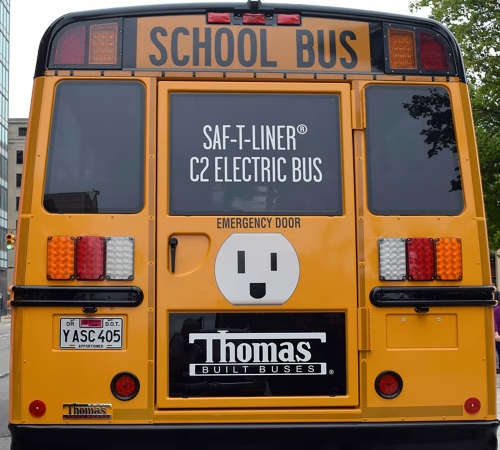AAPS was one of the first school districts in Michigan to use electric school buses. After a slow but successful pilot program, the district targets using 100% electric school buses by 2035*.
Ann Arbor Public Schools is taking steps to become environmentally sustainable by reducing pollution and waste. The goal for reducing pollution is very ambitious: no direct carbon emissions by 2035. The majority of these direct emissions at AAPS come from the burning of natural gas for space and water heating, as well as diesel and unleaded gasoline for buses and fleet vehicles. A very large part of making this no direct carbon emissions by 2035 goal a reality is replacing all one hundred and thirty-one of AAPS general education school buses with electric buses by 2035*.
*Incentives and support from federal, state and local agencies, as well as utilities, will be necessary to meet this target.
Five Key Takeaways on Electric School Buses and Sustainable Student Transportation:
- The Environmental Sustainability Framework, the plan AAPS is implementing across the district, aims for the bus fleet to produce no carbon emissions by 2035.
- Electric buses have health benefits as well as being good for the environment.
- In ten years AAPS endeavors to transition all one hundred and thirty-one buses to electric vehicles. AAPS targets bringing ten to sixteen new electric buses into the transportation fleet every year.
- AAPS is creating partnerships and seeking incentives and grant opportunities to increase the financial viability of electric buses and charging infrastructure.
- AAPS is a leader in Michigan, overcoming obstacles and providing an example as an early adopter that other school districts can learn from.
Going Green at AAPS
Ann Arbor Public Schools has been a regional leader in environmental sustainability for decades. In 2022, their Environmental Task Force created an action plan to significantly reduce the district’s carbon footprint in the next decade. The strategic plan, or “Environmental Sustainability Framework,” prioritizes responsible operations and tasks the district with switching to renewable energy sources and ending all direct carbon emissions by 2035.
A major project of the plan is to exchange all diesel buses owned by the district for electric school buses. Even though diesel engines have become cleaner over the past decades, diesel engines still produce 25% of the CO2 emissions created by transportation in the US. A diesel school bus is responsible for 363 tons of carbon emission during its service life. By contrast, electric buses utilizing clean renewable electricity don’t create carbon emissions from operating. In order to charge the buses with clean energy, AAPS is working closely with energy provider DTE to only access electricity generated by renewable resources, such as wind and solar. This way, the electricity used by the district’s buses will not generate carbon emissions either, further reducing Ann Arbor Public Schools’ carbon footprint.
Beneficial Buses
Switching to electric school buses brings advantages for students and the community as a whole. In addition to reducing the district’s carbon footprint in a big-picture way, electric buses can also improve the quality of life for AAPS students. The first quality-of-life improvement is better air quality, because electric buses don’t emit polluting fumes. Second, the electric buses are quieter—a quality-of-life improvement for everyone inside the bus. On a quieter bus, it is easier to talk rather than having to shout over the engine noise to be heard. A third quality-of-life improvement from electric buses is comfort. Electric buses are easier to drive, provide a smoother ride, and they warm up quickly on cold days and cool down quickly on hot days—all elements that make for a more comfortable trip to and from school. Finally, newer electric buses can be equipped with built-in harnesses for seat belt connections, making it easier to transport early childhood students and students with special needs.
On June 12, 2024, representatives from the White House and the US Environmental Protection Agency recognized Ann Arbor Public Schools. Ann Arbor Public Schools is proud to be an early adopter of electric school buses, participating in the EPA’s Clean School Bus program and demonstrating that electric school buses are a viable and practical option for sustainable, safe student transportation.
Making Transportation Changes
Currently, AAPS has one hundred and thirty-one general education buses that serve the transportation needs of students across the district. In order to end direct emissions by 2035, Ann Arbor Public Schools is steadily phasing out the diesel buses and phasing in electric buses. As of January 2025, there are four electric buses serving routes for AAPS with four more starting routes in April. During spring 2026, six more electric buses will join the fleet for a total of fourteen electric buses transporting students to and from schools for the 2026/2027 school year. AAPS has also applied for grant funding to purchase an additional ten buses at the end of 2026 or early 2027.
Ann Arbor Public Schools has an excellent track record of taking care of the district’s buses, including a schedule for replacing old buses promptly at the end of service life. Liz Margolis, director of school safety and district operations, shared that, because of this replacement schedule, the district has a proven process for bringing new buses into the fleet and preparing them to serve student routes. Now that the new buses are electric, this process has become more involved. But the district is adapting quickly to the changes, which include training drivers, ensuring maintenance staff is trained and certified to work on the electric buses, and integrating the electric buses into the existing routes.
Lessons Learned by Overcoming Challenges
Ann Arbor Public Schools was one of the first districts to start using electric school buses in Michigan back in 2019. Being on the leading edge of a new technology comes with challenges, and the district had to learn quickly. At first there were some difficulties with vehicle maintenance issues that caused them to be out of service for longer than diesel buses. After bus technology issues were resolved, some charging infrastructure challenges emerged. Despite the bumpy start, AAPS has developed forward-thinking, long-term solutions that will support the transition to 100% electric buses over the next ten years.
The charging difficulties were solved by working with energy company DTE, to ensure that charging stations were operating as designed, were configured as simply as possible, and delivered enough electricity to charge the batteries carried by the electric buses, which are larger and more complex than those of electric cars. The maintenance difficulties are being mitigated by providing continuing education opportunities for bus maintenance staff to go beyond basic training to become certified in EV maintenance. This way, bus maintenance crews have on-site specialists, along with dealer support mechanics, to address any potential maintenance needs for the EVs before they become problems that take a bus out of service. This process took several years to implement, especially because of external disruption to school operations during 2020 and 2021 caused by the global pandemic. However, progress has been steady and the 2023/2024 school year saw the initial four electric buses running on a regular schedule as compared to the diesel buses.
Moe Nagpal, manager of construction projects for the AAPS Capital Program, explained that electric buses are especially suited to school transportation because of mid-day off-route times where buses can be charging. The district has had to learn how to plan the bus routine for efficient battery usage, such as warming up or cooling down the temperature of the bus cabin for the students before unplugging from the charging station to save battery for driving. Learning from the early challenges, Nagpal and the Capital Program staff of AAPS are confident that using the phased approach to bringing new electric buses into the fleet will ensure that the infrastructure for charging stations and bus maintenance is ready to accommodate the growing number of EVs until the entire fleet has been exchanged.
Building Infrastructure and Partnerships
Taking a phased approach to the electrification of AAPS buses is designed to make the transition smooth and successful. For the transition to all electric buses by 2035, the district needs good infrastructure and strong partnerships, and AAPS is making progress on both. Electrical infrastructure setup for EVs is underway in the smaller of the district’s two bus lots, where thirty-five of the buses are parked. Each bus will have its own charging station, and management software will help distribute power efficiently and cost effectively. Working with the renewable energy and electric vehicle teams at DTE has been key in planning ahead for the fleet’s power needs and overcoming limitations. Despite the challenges of being early adopters of a new technology, ongoing investment and careful planning are setting the district on course to overcome potential issues and steadily transition to electric bus transportation for students.
Electric School Buses are a wise investment in the future of the students and in the operations of Ann Arbor Public Schools student transportation. Lower fuel expenses, fewer maintenance needs, and grant funding make owning and operating an electric school bus less costly than their diesel school bus counterparts. AAPS will continue to work with the US Environmental Protection Agency’s Clean School Bus Program and other programs such as Michigan’s Clean Bus Energy Grant to support the district’s transition to 100% electric buses by 2035. These funding opportunities help the district adhere to the bus replacement timeline, integrate new electric buses into the fleet, and leverage both grant and bond funding for financial sustainability.
Looking Ahead: Future of Electric School Buses
The Environmental Sustainability Framework adopted by AAPS in 2022 outlines that the district aims to have an all-electric school bus fleet by 2035. With certain grants, incentives, and funding mechanisms in jeopardy, these goals and timelines may be impacted. However, AAPS remains committed to leveraging every funding resource available to meet this benchmark efficiently and economically.
In the meantime, improvements in electric vehicle technology, like longer ranges and quicker charging, will make electric buses even better for school districts over time. Ann Arbor Public Schools is making sure that students are able to get to school safely and on time through their phased implementation plan. By rolling out the program gradually, they can avoid service interruptions while making necessary upgrades.
As an early adopter and one of the first districts in Michigan to use electric buses, AAPS sets a great example for others and shows how smart transportation solutions can help the environment and students. Even though there were difficulties at the start of this sustainability journey, the lessons learned by AAPS can help other school districts—especially smaller districts with fewer resources—avoid the bumpy start and develop an electric school bus program of their own. This initiative not only enhances student travel but also positions AAPS as a leader in creating cleaner, more sustainable transportation for schools in Michigan.

